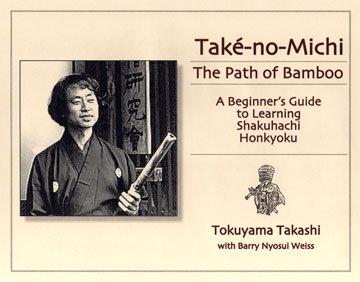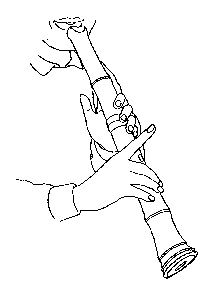
Takashi
Tokuyama
with
Barry Nyosui Houun (大道法雲) Weiss
TAKE-NO-MICHI
-
The Path of Bamboo:
A Beginner's Guide
to Learning
Shakuhachi Honkyoku

|
|
Takashi
Tokuyama TAKE-NO-MICHI
- |
 |
This is a shakuhachi playing guide designed specifically for beginning students with no access to a teacher. Written in clear language, it covers the fundamentals of producing a sound and learning to play Kinko-ryu honkyoku. The keynote of this edition is "simplicity", which is the essence of Tokuyama-sensei's approach to shakuhachi. His main disciple and editor of this instructional guide, Barry Nyosui Weiss, writes about his teacher: "His tone was simple and pure, a reflection of his true spirit. Since our first lesson, I have been going more inside the music, more inside myself. For the rest of my life, I will practice this simple way."
 Chapters
include information and advice on the structure and care of shakuhachi,
practice, posture, breath, embouchure, how to hold the instrument,
finger positions and making your first sound. It provides an explanation
of the basic 5-note shakuhachi scale, timing and rhythm before
teaching you how to produce each tone in both octaves. Several
practice melodies are taught in a step-by-step method.
Chapters
include information and advice on the structure and care of shakuhachi,
practice, posture, breath, embouchure, how to hold the instrument,
finger positions and making your first sound. It provides an explanation
of the basic 5-note shakuhachi scale, timing and rhythm before
teaching you how to produce each tone in both octaves. Several
practice melodies are taught in a step-by-step method.
Once the fundamentals are mastered, Tokuyama teaches the student some of the more nuanced aspects of playing Kinko honkyoku on the shakuhachi. He illustrates the proper head positions for meri and kari notes as well as special fingerings for the highest notes played on the instrument.
An accompanying CD including 29 lessons, as well as a fingering chart and many excellent illustrations are included in this edition.
2nd Edition. 65 pages. PG-4 Published by Tai Hei Shakuhachi ISBN: 0-9722878-3
Takahashi Tokuyama has studied with several senior shakuhachi masters, but aligns himself with no particular school. His recordings are entirely from the ancient traditional Japanese shakuhachi masterworks collection, the Koten honkyoku. In Tokyo, sensei Tokuyama leads a school for the study of traditional shakuhachi, the Honkyoku Study Group. Nowadays in Japan there are few people keeping this ancient musical tradition alive.
Barry Nyosui Houun Weiss (大道法雲) first heard the sound of the shakuhachi before boarding a Brooklyn subway (on his way to work). Well, he never made it to work. Instead, he went to a concert of shakuhachi in Manhattan and has been following the “Path of Bamboo” ever since. In early 1974, he became the first student (deshi) of Ronnie Nyogetsu Seldin. In 1980, he was lucky enough to study with Nyogetsu’s teacher, the late Kurahashi Yodo of Kyoto (a student of Jin Nyodo) and received his teaching license (Jun shi han) at that time. In 1981, Barry received his Shi han license. In 1988, Barry met Takashi Tokuyama and for 15 years had been focused on bringing his simple way to the shakuhachi world. Barry is presently living at a Zen temple in Japan and continues to focus on both his Zen practice and shakuhachi. He is now an ordained zen monk, his teacher is the venerable Harada Tangen Roshi from Bukkokuji Temple in Obama City, Fukui, it is a soto-shu (Dogen) temple. Currently Barry works with Takahashi Suiko, a komuso from Ichikawa City, they have been active in helping to rebuild Ichigetsuji-do, now located at Manmanji Temple in Matsudo City, Japan.
|
Recorded Music Honkyoku Sheet Music Scores |
| Price of Book | Ordering Information |